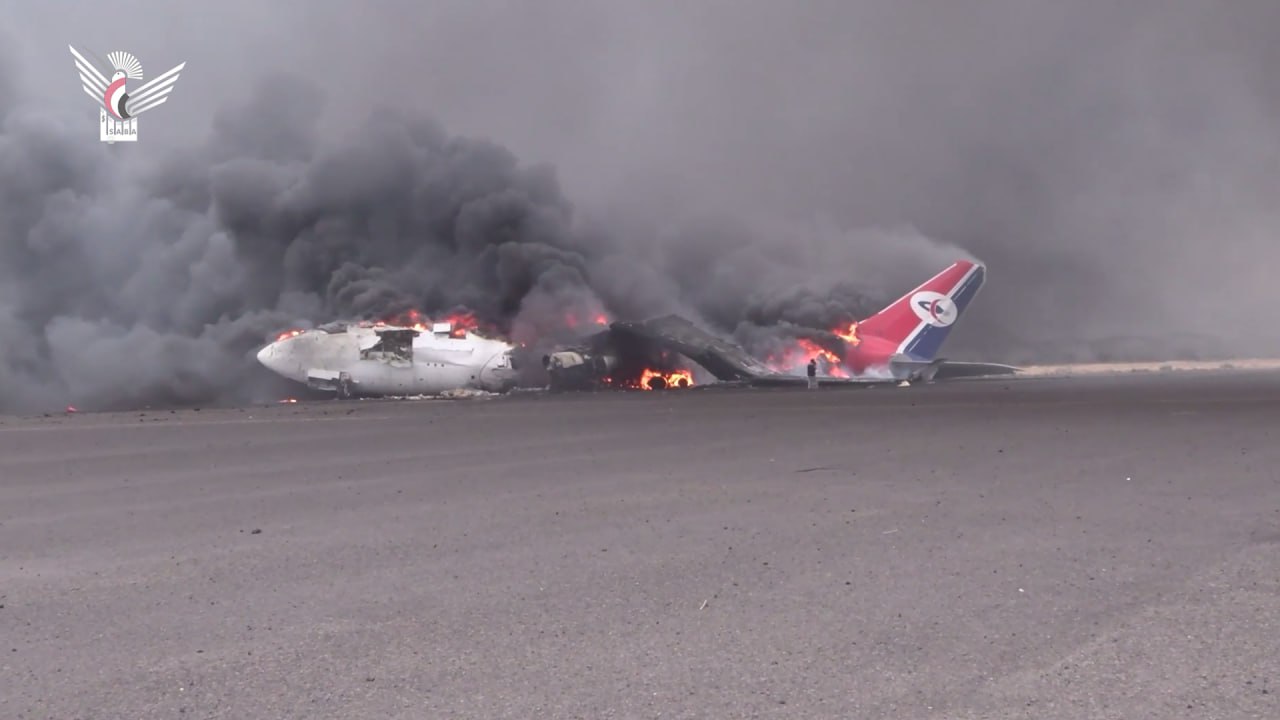
A photo of a civilian aircraft on fire at Sanaa International Airport following an Israeli airstrike, May 6, 2025 (Saba News Agency, run by the Houthis).
Last updated on: 07-05-2025 at 11 AM Aden Time
|
|
Sanaa (South24 Center)
In a renewed military escalation, the Israeli military announced on Tuesday, May 6, that it had carried out a series of airstrikes targeting Sanaa International Airport and several key infrastructure facilities under the control of the Houthi group. The strikes came in retaliation for the ballistic missile attack launched by the group on Sunday near Israel’s Ben Gurion International Airport outside Tel Aviv.
An Israeli military spokesperson said the strikes targeted “terrorist infrastructure” at Sanaa airport, allegedly used for transferring weapons and operatives, adding that the operation resulted in the “complete shutdown” of the facility.
Prior to the strikes, IDF Arabic-language spokesperson Col. Avichay Adraee issued a warning on X (formerly Twitter), urging civilians to evacuate the airport area immediately. He posted a map and wrote: “Failure to evacuate puts your lives at risk.”
Following the warning, Israeli media outlets, including Kan and Channel 12, reported that Israeli aircraft had entered Yemeni airspace and struck Sanaa Airport and adjacent sites.
According to Israeli sources cited in Hebrew-language media, the bombardment targeted the airport's control tower, runways, and passenger terminal, causing total destruction and rendering the facility inoperable.
The Director of Sanaa International Airport stated that the Israeli airstrikes destroyed six aircraft, three of which belonged to Yemenia Airways. In remarks carried by Houthi-affiliated media on Wednesday (May7), he added that the strikes completely destroyed the airport terminals, their equipment, and the catering building. According to the Houthi official, the estimated losses caused by the Israeli bombing of the airport amount to $500 million.
In a related statement issued Tuesday from its headquarters in Aden, Yemenia Airways confirmed that three of its aircraft — an A320-AFA, A320-AFC, and A330-AFE — were destroyed in the strikes. The planes had been seized by the Houthis years earlier and were stationed at the airport.
Yemenia described the destruction as a “major devastating loss” that deepens the company’s operational and financial challenges.
The Houthis’ Al-Masirah TV reported that Israeli airstrikes also hit the Dhahban Central Power Plant in northern Sanaa, the Haziz Power Station in the south, and the Asr Power Station in Maeen District. A cement factory in Amran province was also struck.
The Israeli military stated that the cement plant was being used in the construction of tunnels and military infrastructure, describing it as a strategic economic asset for the Houthi leadership.
Tuesday’s strikes followed an earlier wave of Israeli airstrikes less than 24 hours prior, which targeted the port of Hodeidah and nearby industrial facilities.
In its first official response to the latest attacks, the Houthi-run Supreme Political Council described the Israeli airstrikes as “a double aggression” and declared that Yemen reserves “the right to respond.”
The Israeli escalation came two days after the Houthis launched a ballistic missile from Yemeni territory that landed near Terminal 3 of Ben Gurion Airport, breaching Israeli air defenses. The missile caused no casualties but created a deep crater and prompted several international airlines to suspend flights to Tel Aviv temporarily.
In the aftermath of the missile strike, the Houthis announced they would enforce a full “aerial blockade” on Israel in response to its expanding military operations in Gaza.
Meanwhile, U.S. President Donald Trump made a series of remarks on Tuesday, stating that the Houthis had “surrendered” and were willing to halt attacks if airstrikes against them ceased. Trump also said he would make a “major announcement” before heading to the Middle East. He claimed that the Houthis had informed they “no longer want to fight” and were ready to de-escalate.
Since March 15, the United States has conducted near-daily airstrikes on Houthi-linked targets in Sanaa, Hodeidah, and other northern provinces. Washington says the campaign aims to secure international shipping lanes and prevent Houthi attacks on commercial vessels in the Red Sea and Gulf of Aden.
In a related development, Oman’s Ministry of Foreign Affairs announced on Tuesday that recent discussions and communications conducted by the Sultanate with the United States and the authorities in Sanaa have led to a ceasefire agreement between the two sides. According to an official spokesman, both parties have agreed not to target one another going forward — including refraining from attacks on American vessels in the Red Sea and Bab al-Mandab — in a move aimed at ensuring freedom of navigation and the smooth flow of international commercial shipping.
Oman expressed its gratitude to both sides for what it described as a constructive approach that resulted in the “welcomed outcome,” and voiced hope that the agreement would contribute to broader progress on regional issues in pursuit of justice, peace, and prosperity for all.